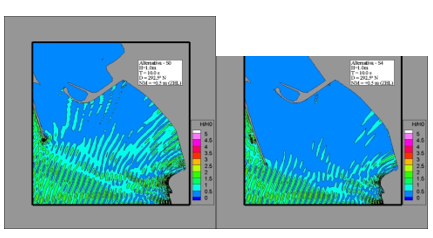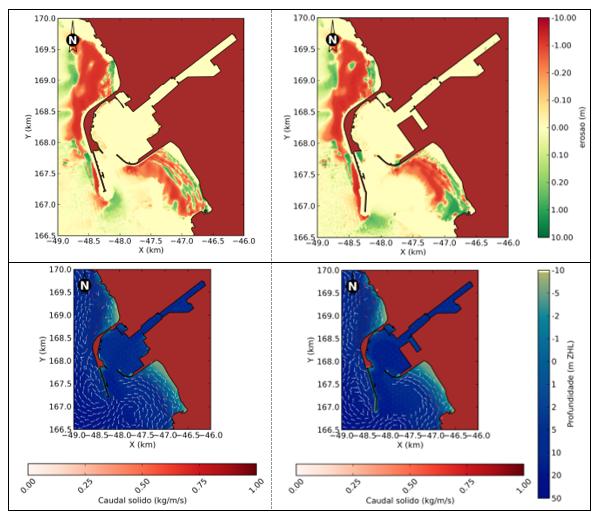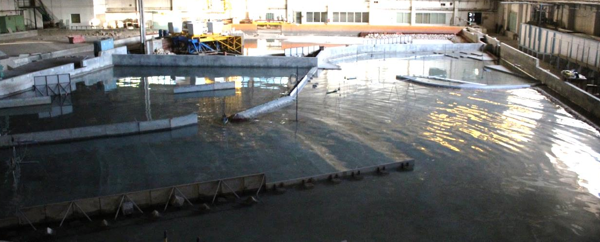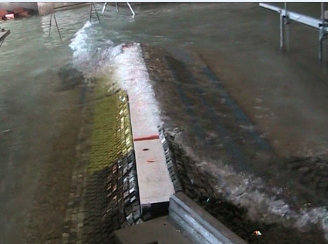 Hydraulics and Environment Department
Hydraulics and Environment Department
Studies - Studies in Physical and Numerical Model of the Breakwater’s Extension of the Port of Leixões
With the goal of studying the best solution for the
extension of its outer breakwater in order to increase its sheltering
conditions and allow the entrance of container ships up to 300 m in
length, numerical and physical modelling of wave propagation in Leixões
harbour were performed. The current layout and 6 alternatives of the
extension were tested.
The impacts of the different alternatives were analysed using numerical modelling, regarding resonance inside the port, sediment dynamics and wave conditions for surfing practice at Matosinhos beach.
Numerical modelling of wave propagation and impact of the breakwater’s extension
The evaluation of the extension’s impact in wave conditions at Matosinhos beach, was performed using finite element numerical model DREAMS (Fortes, 1993) for short-term maritime agitation.
The numerical model DREAMS is based on the Berkhoff mild slope equation (1972) and allows to carry out studies of wave propagation in ports and sheltered areas, as well as port resonance studies.

The purpose of the resonance study was to analyse the outer breakwater extension’s influence on the wave amplification factors within the port basin, for long period waves. The simulations with DREAMS were made for the current layout and for six configurations of the outer breakwater extension of the Port of Leixões.

Sediment dynamics studies in the vicinity of the port
The morphological changes due to the extension of the Port of Leixões’ outer breakwater were determined. The study was carried out using field data analysis and the application of several numerical models: a coupled circulation, wave and sedimentary dynamics model, (SCHISM-WWM-SED2D, Zhang et al., 2016; Roland et al., 2012 and a model for beach evolution (LITPACK, DHI, 2016). These complementary approaches allowed us to draw consistent conclusions about current and future sediment dynamics (see figure below). The extension of the breakwater will reinforce the existing trend of rotation of Matosinhos beach in the counter-clockwise direction. This rotation will significantly reinforce the sand accumulation trend at the northern end of the beach.

Geometry optimization for the extension of the Port of Leixões’ outer breakwater
In the scope of geometry optimization studies for the extension of the Port of Leixões’ outer breakwater, two wave tanks and one flume from the experimental facilities of the Department of Hydraulics and Environment (DHA) were used.
First, in a two-dimensional flume, two cross sections of the structural design were tested (Profile 1 and Profile 2) at a 1:61 scale. The tests were performed for three wave periods (12 s 16 and 20 s), significant wave heights from 6 m to 14 m and two tidal levels (+0.0 m ZHL and +4.0 m ZHL).
Then a three-dimensional physical model was carried out at a 1:80 scale, representing the port basin up to the entrance of Leça River, and South and North breakwaters, considering a 300 m extension with an opening angle of 20 ° relative to the alignment of the existing North breakwater. Regarding the interior of the Port, a new port configuration and the dredging of the access channel up to 16.85 m (ZHL) and of the rotating basin up to -15.5 m (ZHL) proposed by APDL (2016).

Finally, a second three-dimensional reduced model was built to reproduce only the head and trunk of the future breakwater extension (about 300 m), this time to perform stability and overtopping studies. This physical model was constructed at a 1:63 scale, and included the bathymetry around the breakwater’s extension head and about 50 m of the existing breakwater. Wave characteristics were measured in six points located along the alignment of the outer slope of the breakwater, as well as along the port’s access channel.

Institutions and team members:
LNEC
HYDRAULICS AND ENVIRONMENT DEPARTMENT
Conceição Juana Fortes
Maria da Graça Neves
Rui Capitão
Rute Lemos
Liliana Pinheiro
André Ramos
Branca Branco
Joana Simão
Jan André Hilário
Luís Gabriel Silva
Pedro Guerreiro
Rosa Emília Soares
André Fortunato
Paula Freire
Filipa Oliveira
Year : 2017/2018
References
The impacts of the different alternatives were analysed using numerical modelling, regarding resonance inside the port, sediment dynamics and wave conditions for surfing practice at Matosinhos beach.
Finally, this analysis was complemented with the
optimization of the geometry of the breakwater’s extension, resorting to
tests in scaled physical models for wave characterization, stability
and overtopping.
Numerical modelling of wave propagation and impact of the breakwater’s extension
The evaluation of the extension’s impact in wave conditions at Matosinhos beach, was performed using finite element numerical model DREAMS (Fortes, 1993) for short-term maritime agitation.
The numerical model DREAMS is based on the Berkhoff mild slope equation (1972) and allows to carry out studies of wave propagation in ports and sheltered areas, as well as port resonance studies.

Wave height indexes for incident wave condition: T = 10 s, D = 292.5 ° and NM = + 0.5 m (ZHL) for the current layout and one of the tested configurations.
The purpose of the resonance study was to analyse the outer breakwater extension’s influence on the wave amplification factors within the port basin, for long period waves. The simulations with DREAMS were made for the current layout and for six configurations of the outer breakwater extension of the Port of Leixões.

Amplification coefficient diagrams for 60s and 160s wave periods. Current layout.
Sediment dynamics studies in the vicinity of the port
The morphological changes due to the extension of the Port of Leixões’ outer breakwater were determined. The study was carried out using field data analysis and the application of several numerical models: a coupled circulation, wave and sedimentary dynamics model, (SCHISM-WWM-SED2D, Zhang et al., 2016; Roland et al., 2012 and a model for beach evolution (LITPACK, DHI, 2016). These complementary approaches allowed us to draw consistent conclusions about current and future sediment dynamics (see figure below). The extension of the breakwater will reinforce the existing trend of rotation of Matosinhos beach in the counter-clockwise direction. This rotation will significantly reinforce the sand accumulation trend at the northern end of the beach.

Simulation of the sedimentary dynamics in the Leixões Port with the SCHISM model for the current configuration (left) and one alternative solution (right): morphological evolution (above) and residual solid flow rates (below). Extracted from Fortunato et al. (2017)
Geometry optimization for the extension of the Port of Leixões’ outer breakwater
In the scope of geometry optimization studies for the extension of the Port of Leixões’ outer breakwater, two wave tanks and one flume from the experimental facilities of the Department of Hydraulics and Environment (DHA) were used.
First, in a two-dimensional flume, two cross sections of the structural design were tested (Profile 1 and Profile 2) at a 1:61 scale. The tests were performed for three wave periods (12 s 16 and 20 s), significant wave heights from 6 m to 14 m and two tidal levels (+0.0 m ZHL and +4.0 m ZHL).
Then a three-dimensional physical model was carried out at a 1:80 scale, representing the port basin up to the entrance of Leça River, and South and North breakwaters, considering a 300 m extension with an opening angle of 20 ° relative to the alignment of the existing North breakwater. Regarding the interior of the Port, a new port configuration and the dredging of the access channel up to 16.85 m (ZHL) and of the rotating basin up to -15.5 m (ZHL) proposed by APDL (2016).

Aspect of a wave propagation test with SW heading.
Finally, a second three-dimensional reduced model was built to reproduce only the head and trunk of the future breakwater extension (about 300 m), this time to perform stability and overtopping studies. This physical model was constructed at a 1:63 scale, and included the bathymetry around the breakwater’s extension head and about 50 m of the existing breakwater. Wave characteristics were measured in six points located along the alignment of the outer slope of the breakwater, as well as along the port’s access channel.

Wave direction: West. Aspect of an overtopping event and vortex observed during a test with tidal level of +4.0 m (ZHL), Tp = 20 and Hs = 11 m
Institutions and team members:
LNEC
HYDRAULICS AND ENVIRONMENT DEPARTMENT
Conceição Juana Fortes
Maria da Graça Neves
Rui Capitão
Rute Lemos
Liliana Pinheiro
André Ramos
Branca Branco
Joana Simão
Jan André Hilário
Luís Gabriel Silva
Pedro Guerreiro
Rosa Emília Soares
André Fortunato
Paula Freire
Filipa Oliveira
Alberto Azevedo
References
- Berkhoff J. C. W.1972 Computation of combined refraction-diffraction. Proc. 13th Conf. Coastal Engineering, pp. 471–490. ASCE.
- DHI 2016. Litpack. Noncohesive Sediment Transport in Currents and Waves. User Guide. Danish Hydraulic Institute, Denmark.
- Fortes, C.J.E.M. (1993). Modelação matemática da refração e difração combinadas de ondas marítimas (análise pelo método dos elementos finitos). Tese de Mestrado em Engenharia Mecânica, IST, Lisboa, Portugal.
- Fortunato, A.B., Freire, P., Oliveira, F.S.B.F., Azevedo, A., Pinheiro, L. 2017. Impacte do prolongamento do quebra-mar norte do porto de Leixões na dinâmica sedimentar, 9as Jornadas Portuguesas de Engenharia Costeira e Portuária, 14 pp.
- Guerin, T., Bertin, X., Dodet, G. 2016. A numerical scheme for coastal morphodynamic modelling on unstructured grids. Ocean Modelling, 104: 45–53.
- Oliveira, A., Fortunato, A.B. 2002. Velapart user’s manual: a quasi-3D particle tracking model for shallow water simulations, Relatório LNEC, 37 pp.
- Roland A, Zhang YJ, Wang HV, Meng Y, Teng Y-C, Maderich V, Brovchenko I, Dutour-Sikiric M, Zanke U. 2012. A fully coupled 3D wave-current interaction model on unstructured grids. Journal of Geophysical Research, 117, C00J33.
- Zhang, Y.J., Ye F., Stanev, E.V., Grashorn, S. 2016. Seamless cross-scale modeling with SCHISM. Ocean Modelling, 102: 64-81.
Year: 2017/2018
Accountable: C. Juana Fortes, Co-respons. Mª Graça Neves
Coordinator(s):
LNEC - Laboratório Nacional de Engenharia Civil (National Laboratory for Civil Engineering)
« return




